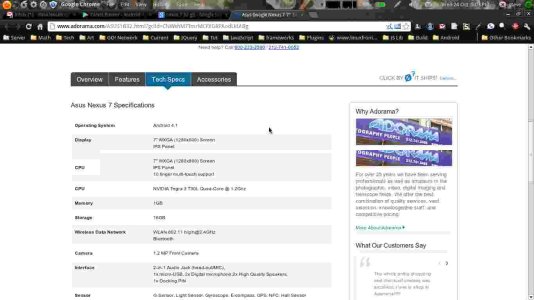- Oct 21, 2012
- 9
- 0
- 0
import ("tl:dr_disclaimer");
First off, this will be my first foray into Android... but I have worked with Linux for several years as my primary (and often only) OS. I had my introduction to smartphones via the iPhone 3, then 3g, 4, and 4s... and have jailbroken them all. I stayed with iOS until now due to the prevalence of apps on iOS, and the lack of malware. I quit iOS because it is so completely inflexible (even after jailbreak), and after a while now, I have realized that it will *never* change. Similarly, I stayed away from tablets until now because I saw no real point in a 10"+ one, and the 7"- ones all seemed a bit low on specs/features until now.
I will be getting the Nexus 7 in 8 days now (Oct 29), when the final version (32GB) is released. I would like to thank all of you that tested and debugged the alpha (8GB) and beta (16GB) versions. It is nice to know that most of the bugs have gotten worked out.
I would like to understand the differences between the various kernels and ROMs available.
I understand "what's best for me isn't necessarily what's best for you" and "open source is about choice" and "try them all!"; as I stated, I come from a Linux background, and this seems a lot like the distro wars to me... however, while open source *IS* all about choice, it often falls into a long, buggy, 'brick' laden path of trial and error going from one [distro|ROM|Kernel] to the next until you find one that you are happy with (except you want a few features from somewhere else, and spend months trying to splice the two... and failing/bricking/reformatting, etc. )
)
I would like to avoid that kind of PIA.
It seems to me that while open source *is* about choice, that choice should be able to be an educated one.
Is there any existing comparison list of the multitudinous kernels and ROMs? For linux, if I am after a new distro, I can usually get good intel from DistroWatch, YouTube, and numerous websites all comparing the high and low points of each distro. With android, from what I have found, all I seem to find is lists of randomly named features ('Hybrid Mode', 'Custom NavBar Ring', 'DPI Switcher', etc), all of which are 'the BEST' (with the disclaimer 'my best is not your best, try them all'), and none of which are able to provide any real specs.
I have read up on Cyanogen, Liquid Jelly Bean, Kang, Paranoid Android, and seen a few screenshots (like those tell you anything) of 'Sourcery Jelly Bean HD2' (listed as 'awesome' without explanation)... The only ones I have seen anything more substantial on are Cyanogen, Kang, and Paranoid... Paranoid, I really do not see the point of having the option of a cell phone layout on my 7" tablet, so unless there is something compelling, I will probably skip. Kang seems like a complex swiss army knife to allow you to customize well (like KDE, a plus so far - though I use Gnome 2 generally), but there must be more to it than that. Cyanogen is pretty up front about a lot of its features (DSP EQ [nice], Theming [which i assume every ROM does], and Incognito [which I don't care about])... but this helps little unless I can actually compare it to something.
To be fair, I probably *WILL* try several of these, just for fun, and to learn more about the platform... but I don't really care for the idea of spending a month of trial and error before finding something that I really like. Rather, I would like to have my normal tablet mode stored on a backup on my laptop, then go experimenting and be able to revert whenever I like; the exact same reason I burned my personal linux distro to thumb drive...
If there *IS* a detailed comparison list of these somewhere, please let me know... if not, I may create a wiki for them (after all, this *is* open source) in a few months (once I have felt my way through some of the more popular ones).
Same question with kernels... I have seen people freak out about Trinity (although, overclocking a tablet with no real cooling would really kinda concern me, and that's really all I know about the Trinity kernel), while others are pretty solid on Franco (without mentioning why), etc. To be honest, the idea of reflashing kernels again and again and again seems a real hassle without even knowing what you are going to get for your trouble beforehand (not to mention compatibility issues, etc.).
I would really look for the ability to customize appearences to my hearts content while retaining smoothness.... I *might* OC just a hair after a while, but would be mild to moderate. I have heard about fast charging, and that would be really useful... I will be blunt, though... I'm not sure what all features are even available in kernels and ROMs, and sometimes the features that aren't on the back of the tin end up being must-haves (I still use Gnome 2 because my workflow basically demands Compiz Cube).
If someone is willing to make recommendations, that is always welcome, and I will go more in depth about what I would like in terms of features... but once again, many of the features I might not even know about until I stumble into them. Really though, I was hoping there would be a generic wiki-like resource for these things where i could peruse and compare the different options available in the next few days before the 29th.
Anyone?
First off, this will be my first foray into Android... but I have worked with Linux for several years as my primary (and often only) OS. I had my introduction to smartphones via the iPhone 3, then 3g, 4, and 4s... and have jailbroken them all. I stayed with iOS until now due to the prevalence of apps on iOS, and the lack of malware. I quit iOS because it is so completely inflexible (even after jailbreak), and after a while now, I have realized that it will *never* change. Similarly, I stayed away from tablets until now because I saw no real point in a 10"+ one, and the 7"- ones all seemed a bit low on specs/features until now.
I will be getting the Nexus 7 in 8 days now (Oct 29), when the final version (32GB) is released. I would like to thank all of you that tested and debugged the alpha (8GB) and beta (16GB) versions. It is nice to know that most of the bugs have gotten worked out.
I would like to understand the differences between the various kernels and ROMs available.
I understand "what's best for me isn't necessarily what's best for you" and "open source is about choice" and "try them all!"; as I stated, I come from a Linux background, and this seems a lot like the distro wars to me... however, while open source *IS* all about choice, it often falls into a long, buggy, 'brick' laden path of trial and error going from one [distro|ROM|Kernel] to the next until you find one that you are happy with (except you want a few features from somewhere else, and spend months trying to splice the two... and failing/bricking/reformatting, etc.
I would like to avoid that kind of PIA.
It seems to me that while open source *is* about choice, that choice should be able to be an educated one.
Is there any existing comparison list of the multitudinous kernels and ROMs? For linux, if I am after a new distro, I can usually get good intel from DistroWatch, YouTube, and numerous websites all comparing the high and low points of each distro. With android, from what I have found, all I seem to find is lists of randomly named features ('Hybrid Mode', 'Custom NavBar Ring', 'DPI Switcher', etc), all of which are 'the BEST' (with the disclaimer 'my best is not your best, try them all'), and none of which are able to provide any real specs.
I have read up on Cyanogen, Liquid Jelly Bean, Kang, Paranoid Android, and seen a few screenshots (like those tell you anything) of 'Sourcery Jelly Bean HD2' (listed as 'awesome' without explanation)... The only ones I have seen anything more substantial on are Cyanogen, Kang, and Paranoid... Paranoid, I really do not see the point of having the option of a cell phone layout on my 7" tablet, so unless there is something compelling, I will probably skip. Kang seems like a complex swiss army knife to allow you to customize well (like KDE, a plus so far - though I use Gnome 2 generally), but there must be more to it than that. Cyanogen is pretty up front about a lot of its features (DSP EQ [nice], Theming [which i assume every ROM does], and Incognito [which I don't care about])... but this helps little unless I can actually compare it to something.
To be fair, I probably *WILL* try several of these, just for fun, and to learn more about the platform... but I don't really care for the idea of spending a month of trial and error before finding something that I really like. Rather, I would like to have my normal tablet mode stored on a backup on my laptop, then go experimenting and be able to revert whenever I like; the exact same reason I burned my personal linux distro to thumb drive...
If there *IS* a detailed comparison list of these somewhere, please let me know... if not, I may create a wiki for them (after all, this *is* open source) in a few months (once I have felt my way through some of the more popular ones).
Same question with kernels... I have seen people freak out about Trinity (although, overclocking a tablet with no real cooling would really kinda concern me, and that's really all I know about the Trinity kernel), while others are pretty solid on Franco (without mentioning why), etc. To be honest, the idea of reflashing kernels again and again and again seems a real hassle without even knowing what you are going to get for your trouble beforehand (not to mention compatibility issues, etc.).
I would really look for the ability to customize appearences to my hearts content while retaining smoothness.... I *might* OC just a hair after a while, but would be mild to moderate. I have heard about fast charging, and that would be really useful... I will be blunt, though... I'm not sure what all features are even available in kernels and ROMs, and sometimes the features that aren't on the back of the tin end up being must-haves (I still use Gnome 2 because my workflow basically demands Compiz Cube).
If someone is willing to make recommendations, that is always welcome, and I will go more in depth about what I would like in terms of features... but once again, many of the features I might not even know about until I stumble into them. Really though, I was hoping there would be a generic wiki-like resource for these things where i could peruse and compare the different options available in the next few days before the 29th.
Anyone?





